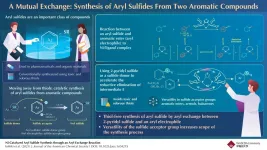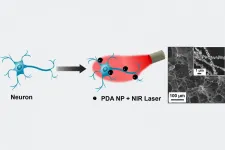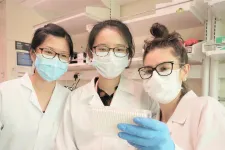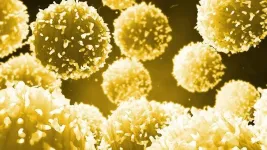A mutual exchange: Synthesizing aryl sulfides from non-smelling, non-toxic compounds
Chemists from Japan develop a thiol-free technique for synthesizing aryl sulfides using a nickel catalyst
2021-07-21
(Press-News.org) Aryl sulfide, an aromatic compound in which sulfur is attached to an aryl (a functional group derived from an aromatic ring), is found in biologically active materials effective against asthma, Alzheimer's disease, and cancer. As a result, chemists have shown a lot of interest in synthesizing aryl sulfides. Traditionally, carbon-sulfur (C-S) bond formation reactions between thiols and aryl electrophiles catalyzed by transition metals have been employed for aryl sulfide synthesis because of their high reliability. However, thiols have an unpleasant smell and are toxic. Could there be a way to synthesize aryl sulfides that avoids the use of thiols?
A team of chemists from Waseda University, Japan, led by Professor Junichiro Yamaguchi addresses this question in a recent study published in the Journal of the American Chemical Society, and has come up with a technique that gets the job done without thiols. The team took the hint from a previous study where they used a nickel catalyst to synthesize aromatic esters from two aromatic compounds. "In 2020, we developed the first ester synthesis method using aromatic ring exchange reactions and decided to apply the knowledge gained from this reaction to realize a thiol-free sulfide synthesis," explains Yamaguchi, speaking of the origin of the study.
Against this backdrop, the team set out to synthesize aryl sulfides and aromatic esters. They started out by reacting 4-tolyl sulfide and 4-phenylbenzoate in presence of a nickel catalyst and found that the desired aryl sulfide was synthesized in the presence of a ligand, dcypt, and a zinc additive, Zn(OAc)2.
Encouraged by the results, the team moved on to investigate the mechanism of the reaction. They reacted the aryl sulfide with the nickel catalyst (Ni(cod)2) and the ligand, dcypt, and observed the formation of a nickel complex consisting of the catalyst, the ligand, and the aryl sulfide. This nickel complex could react with the aromatic ester to form a pair of nickel complexes which could react with each other to form the desired aryl sulfide.
From these reactions, the team concluded that the Ni-catalyzed aryl sulfide synthesis occurred in a sequence of steps. Initially, the aryl sulfide and aromatic esters underwent simultaneous oxidative addition reactions to the nickel/ligand catalyst forming nickel complexes. These nickel complexes could engage in an aryl exchange reaction to form a set of nickel intermediates. This was then followed by the reductive elimination of the intermediates to regenerate the Ni/ligand catalyst and form the desired aryl sulfide.
The reductive elimination of the nickel intermediates, however, reduced the yield of the aryl sulfide. To combat this, the team employed 2-pyridyl sulfide, which accelerated this limiting step, improving the yield. Additionally, the synthesis method worked with several aryl electrophiles such as aromatic esters, arenol derivatives and aryl halides.
"The sulfide synthesis method developed can proceed for a variety of complex bioactive compounds such as probenecid, flavone, estrone, phenylalanine, umbelliferone, and β-isocupreidine derivatives," comments an excited Yamaguchi, contemplating the prospects of their novel synthesis technique. "Furthermore, the ability to use environmentally friendly aromatic esters and phenol derivatives as feedstock and pyridyl sulfide as a sulfide agent could make this technology suitable for both laboratory and industrial-scale applications."
INFORMATION:
Reference
Authors: Ryota Isshiki, Miki B. Kurosawa, Kei Muto, Junichiro Yamaguchi
Title of original paper: Ni-Catalyzed Aryl Sulfide Synthesis through an Aryl Exchange Reaction
Journal: Journal of the American Chemical Society
DOI: https://doi.org/10.1021/jacs.1c04215
Affiliations: Waseda University, Japan
About Waseda University
Located in the heart of Tokyo, Waseda University is a leading private research university that has long been dedicated to academic excellence, innovative research, and civic engagement at both the local and global levels since 1882. The University ranks number one in Japan in international activities, including the number of international students, with the broadest range of degree programs fully taught in English. To learn more about Waseda University, visit https://www.waseda.jp/top/en
[Attachments] See images for this press release:

ELSE PRESS RELEASES FROM THIS DATE:
2021-07-21
A new study of almost 12,000 Australians has found one-third of the adult population has experienced pure cybercrime during their lifetime, with 14% reporting this disruption to network systems in the past 12 months.
With all forms of cybercrime already costing trillions every year globally, experts from the Australian Institute of Criminology (AIC) and Flinders University say the crimes involved substantial levels of personal victimisation including direct losses as well as the high cost of preventing future attacks.
A pre-COVID-19 snapshot of the cost of 'pure cybercrime' in 2019 has found an approximate ...
2021-07-21
Nanomaterials have been used in a variety of emerging applications, such as in targeted pharmaceuticals or to bolster other materials and products such as sensors and energy harvesting and storage devices. A team in the McKelvey School of Engineering at Washington University in St. Louis is using nanoparticles as heaters to manipulate the electrical activity of neurons in the brain and of cardiomyocytes in the heart.
The findings, published July 3, 2021, in Advanced Materials, have the potential to be translated to other types of excitable cells and serve as a valuable tool in nano-neuroengineering.
Srikanth Singamaneni, a materials scientist, and Barani Raman, a biomedical engineer, and their teams collaborated to develop a noninvasive technology that inhibits the electrical ...
2021-07-21
It's hard to save what you can't identify. That's been a problem for the endangered salt marsh harvest mouse, which is found only in the salty, brackish waters of the San Francisco Bay area. The mouse competes for space with about eight million humans, and more than three-quarters of its habitat has been eaten by development and land conversion. That loss is expected to increase amid rising sea levels.
Conserving the population has proven tricky, in part because it looks so much like another mouse in the area--the western harvest mouse--that is abundant throughout western U.S.
But scientists from UC Davis have developed a tool, a "decision ...
2021-07-21
Researchers from the Antimicrobial Resistance (AMR) Interdisciplinary Research Group (IRG) at Singapore-MIT Alliance for Research and Technology (SMART), MIT's research enterprise in Singapore, alongside collaborators from Biobot Analytics, Nanyang Technological University (NTU) and Massachusetts Institute of Technology (MIT), have successfully developed an innovative, open-source molecular detection method that is able to detect and quantify the B.1.1.7 (Alpha) variant of SARS-CoV-2. The breakthrough paves the way for rapid, inexpensive surveillance of other SARS-CoV-2 variants in wastewater.
As the world continues to battle and contain COVID-19, the recent identification of SARS-CoV-2 variants with higher transmissibility and increased severity has made the development ...
2021-07-21
COLUMBUS, Ohio - The parasites that cause severe malaria are well-known for the sinister ways they infect humans, but new research may lead to drugs that could block one of their most reliable weapons: interference with the immune response.
In the study, scientists defined the atomic-level architecture of the connection between a protein on the surface of a parasite-infected red blood cell when it binds to a receptor on the surface of an immune cell.
When that protein-receptor connection is made under normal circumstances, the infected red blood cell, hijacked by the disease-causing parasite, de-activates the immune cell - meaning the body won't fight the infection. A drug designed to fit into that space could block the interaction, allowing the immune system to get to work clearing ...
2021-07-21
LA JOLLA, CA--You can't make a banana split without bananas. And you can't generate stable regulatory T cells without Vitamin C or enzymes called TET proteins, it appears.
Regulatory T cells (Tregs) help control inflammation and autoimmunity in the body. Tregs are so important, in fact, that scientists are working to generate stable induced Tregs (iTregs) in vitro for use as treatments for autoimmune diseases as well as rejection to transplanted organs. Unfortunately, it has proven difficult to find the right molecular ingredients to induce stable iTregs.
Now scientists at La Jolla Institute for Immunology ...
2021-07-21
DALLAS, July 21, 2021 -- Babies who were breastfed, even for a few days, had lower blood pressure as toddlers and these differences in blood pressure may translate into improved heart and vascular health as adults, according to new research published today in the Journal of the American Heart Association, an open access journal of the American Heart Association.
Research has found that cardiovascular disease risk factors, including high blood pressure, can start in childhood. Studies have also confirmed breastfeeding is associated with lower cardiovascular disease risk in adulthood. However, the amount and length of time breastfeeding that is needed ...
2021-07-21
DALLAS, July 21, 2021 -- People who made even small increases in their daily physical activity levels after receiving an implantable cardioverter defibrillator (ICD) experienced fewer incidences of hospitalization and had a decreased risk of death, according to new research published today in Circulation: Cardiovascular Quality and Outcomes, an American Heart Association journal.
Implantable cardioverter defibrillators, also known as ICDs, are battery-powered devices placed under the skin that can detect abnormal heart rhythms and deliver an electric shock to restore a normal heartbeat. According to American Heart Association's Heart Disease ...
2021-07-21
An international collaboration elucidates the mechanisms that facilitate accurate identification of moving images. The findings have been published in Nature Communications
Imagine meeting a friend on the street, and imagine that with every step they take, your visual system has to process their image from scratch in order to recognize them. Now imagine if the same thing were to happen for every object and creature that moves around us. We would live in a constant state of uncertainty and inconsistency. Luckily, that is not the case. Our visual system is able to retain information obtained in motion, thereby presenting us with a more consistent picture of our surroundings. These ...
2021-07-21
Older adults may be slower to learn actions and behaviours that benefit themselves, but new research shows they are just as capable as younger people of learning behaviours that benefit others.
Researchers at the Universities of Birmingham and Oxford found that youngsters, in contrast, tend to learn much faster when they are making choices that benefit themselves.
The study, published in Nature Communications, focused on reinforcement learning - a fundamental type of learning in which we make decisions based on the positive outcomes from earlier choices. It allows us to adapt our choices to our environment by learning the associations between choices and their outcomes.
Dr Patricia Lockwood is senior author on ...
LAST 30 PRESS RELEASES:
[Press-News.org] A mutual exchange: Synthesizing aryl sulfides from non-smelling, non-toxic compounds
Chemists from Japan develop a thiol-free technique for synthesizing aryl sulfides using a nickel catalyst




